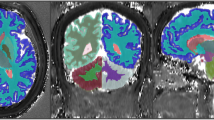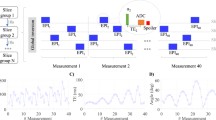Abstract
Magnetic resonance fingerprinting (MRF) is a novel technique that allows for the fast and simultaneous quantification of multiple tissue properties, progressing from qualitative images, such as T1- or T2-weighted images commonly used in clinical routines, to quantitative parametric maps. MRF consists of two main elements: accelerated pseudorandom acquisitions that create unique signal evolutions over time and the voxel-wise matching of these signals to a dictionary simulated using the Bloch equations. In this study, we propose to increase the performance of MRF by not only considering the simulated temporal signal, but a full spatiotemporal neighborhood for parameter reconstruction. We achieve this goal by first training a dictionary from a set of spatiotemporal image patches and subsequently coupling the trained dictionary with an iterative projection algorithm consistent with the theory of compressed sensing (CS). Using data from BrainWeb, we show that the proposed patch-based reconstruction can accurately recover T1 and T2 maps from highly undersampled k-space measurements, demonstrating the added benefit of using spatiotemporal dictionaries in MRF.
Access this chapter
Tax calculation will be finalised at checkout
Purchases are for personal use only
Similar content being viewed by others
References
Aubert-Broche, B., Evans, A.C., Collins, L.: A new improved version of the realistic digital brain phantom. NeuroImage 32, 138–145 (2006)
Aubert-Broche, B., Griffin, M., Pike, G.B., Evans, A.C., Collins, D.L.: Twenty new digital brain phantoms for creation of validation image data bases. IEEE Trans. Med. Imaging 25(11), 1410–1416 (2006)
Davies, M., Puy, G., Vandergheynst, P., Wiaux, Y.: A compressed sensing framework for magnetic resonance fingerprinting. SIAM J. Imaging Sci. 7(4), 2623–2656 (2014)
Doneva, M., Börnert, P., Eggers, H., Stehning, C., Sénégas, J., Mertins, A.: Compressed sensing reconstruction for magnetic resonance parameter mapping. Magn. Reson. Med. 64, 1114–1120 (2010)
Donoho, D.L.: Compressed sensing. IEEE Trans. Inf. Theor. 52, 1289–1306 (2006)
Ma, D., Gulani, V., Seiberlich, N., Liu, K., Sunshine, J.L., Duerk, J.L., Griswold, M.A.: Magnetic resonance fingerprinting. Nature 495, 187–192 (2013)
Ravishankar, S., Bresler, Y.: MR image reconstruction from highly undersampled k-space data by dictionary learning. IEEE Trans. Med. Imaging 30(5), 1028–1041 (2011)
Wang, Z., Bovik, A.C., Sheikh, H.R., Simoncelli, E.P.: Image quality assessment: from error visibility to structural similarity. IEEE Trans. Image Proc. 13, 600–612 (2004)
Author information
Authors and Affiliations
Corresponding author
Editor information
Editors and Affiliations
Rights and permissions
Copyright information
© 2015 Springer International Publishing Switzerland
About this paper
Cite this paper
Gómez, P.A. et al. (2015). Learning a Spatiotemporal Dictionary for Magnetic Resonance Fingerprinting with Compressed Sensing. In: Wu, G., Coupé, P., Zhan, Y., Munsell, B., Rueckert, D. (eds) Patch-Based Techniques in Medical Imaging. Patch-MI 2015. Lecture Notes in Computer Science(), vol 9467. Springer, Cham. https://doi.org/10.1007/978-3-319-28194-0_14
Download citation
DOI: https://doi.org/10.1007/978-3-319-28194-0_14
Published:
Publisher Name: Springer, Cham
Print ISBN: 978-3-319-28193-3
Online ISBN: 978-3-319-28194-0
eBook Packages: Computer ScienceComputer Science (R0)




